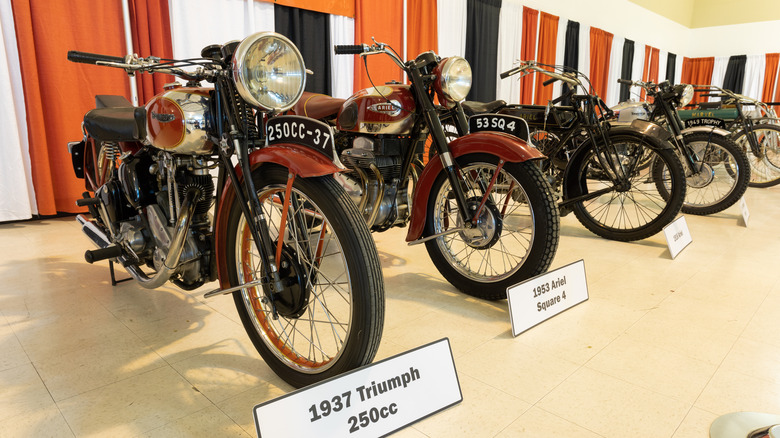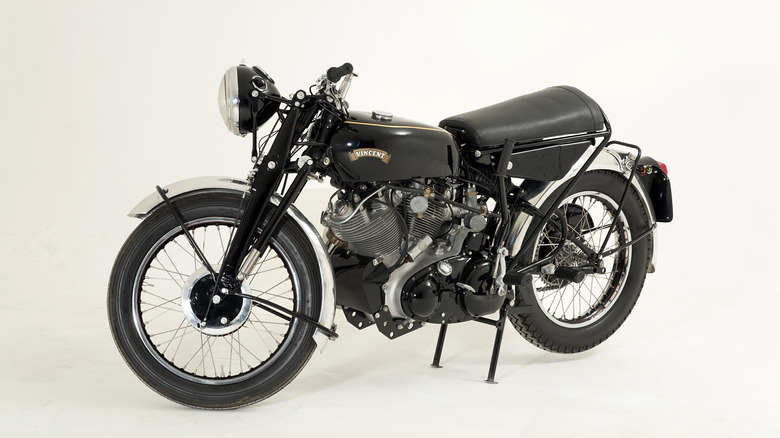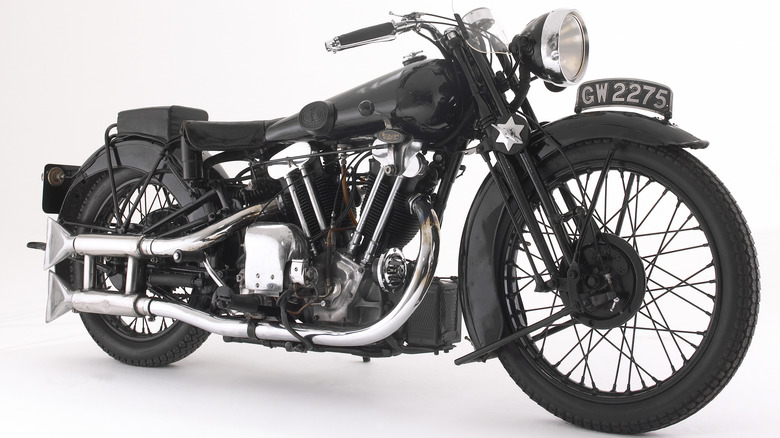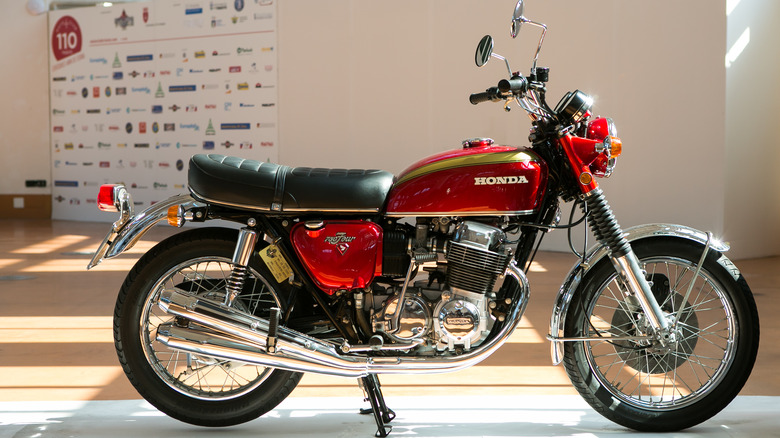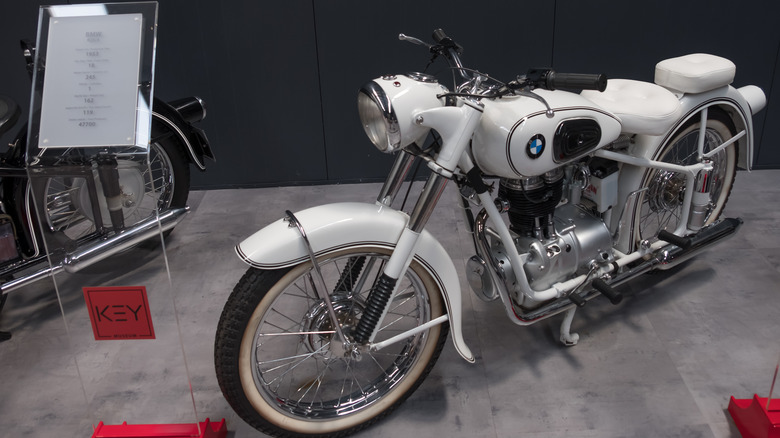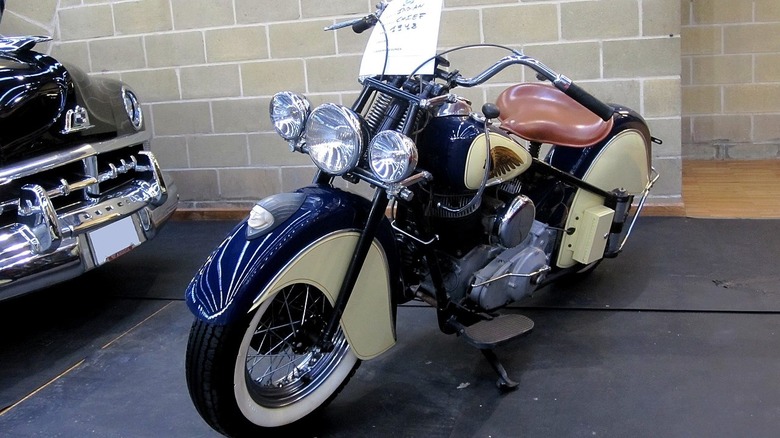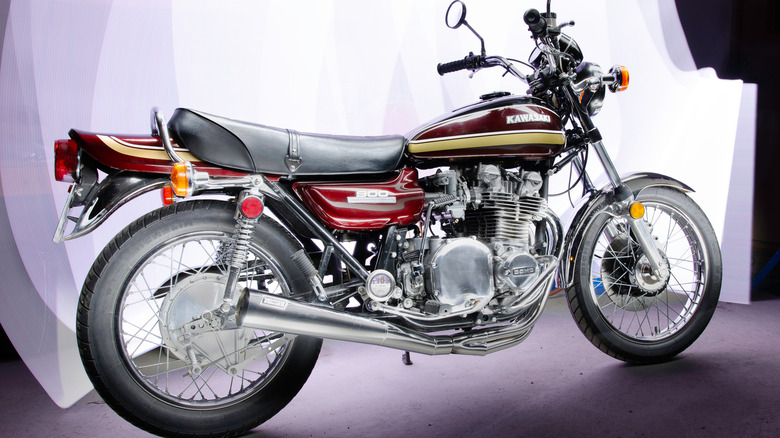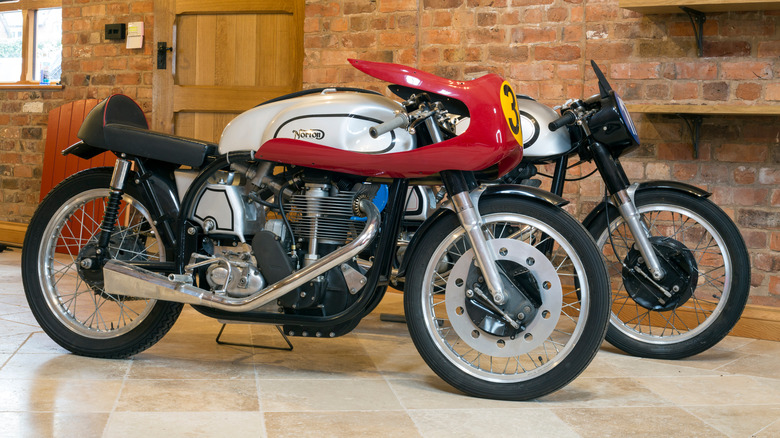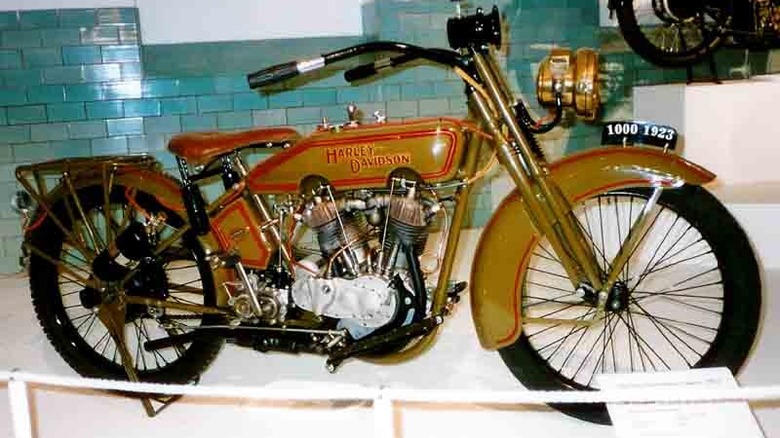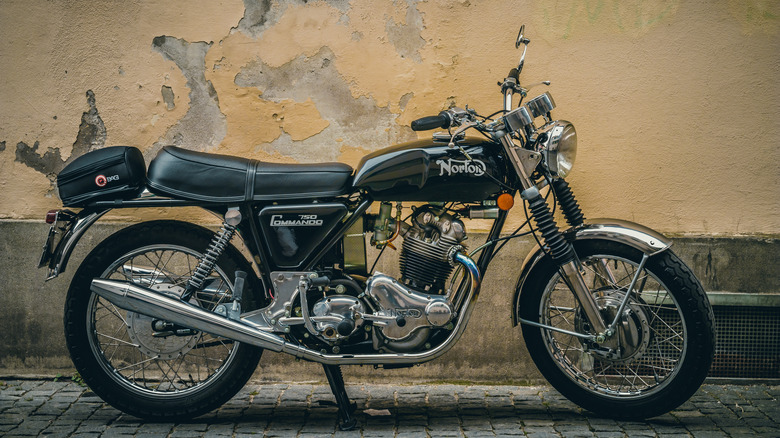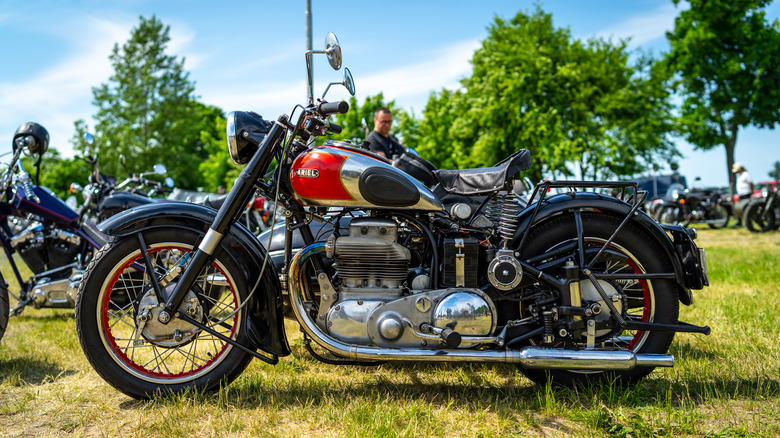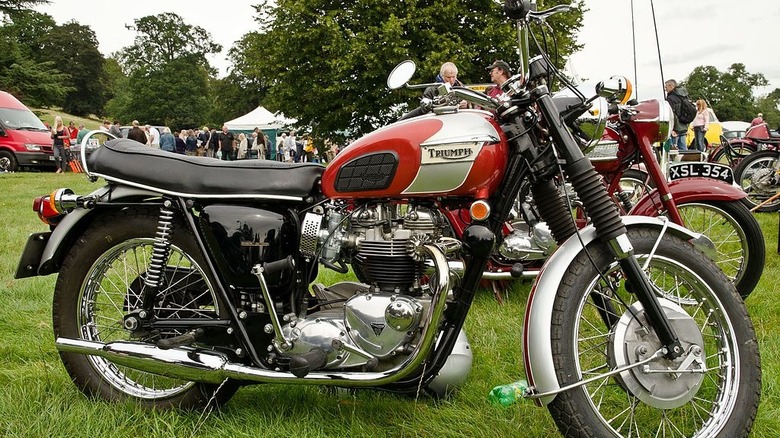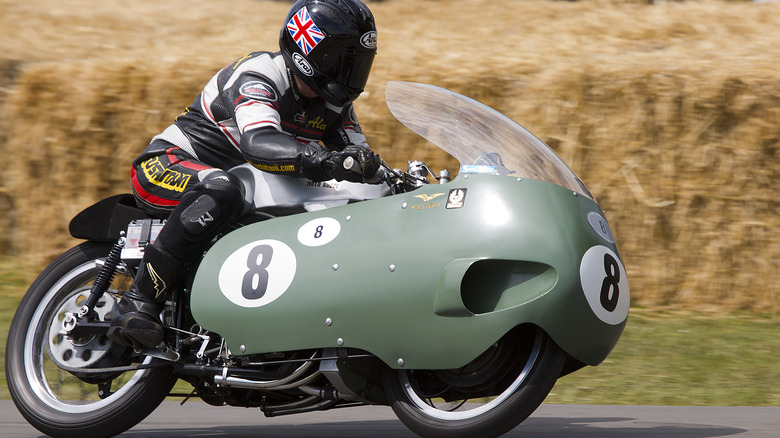12 Vintage Motorcycles Every Collector Would Love To Have
To own one vintage motorcycle, let alone an entire collection, is a labor of love. Parts are difficult to source, maintenance can be tricky, and riding one often feels like you are exposing yourself to unnecessary risk, especially given their dubious handling, reliability issues, and antiquated brakes. However, most motorcyclists could think of at least one vintage machine they would love to own, and if you had the means, the space, and the patience to maintain them, who wouldn't want a collection of classic bikes?
Vintage motorcycle collectors each have their own particular set of preferences, as evidenced by the very different collections of famous enthusiasts such as comedian Jay Leno, Top Gear's Richard Hammond, and actor Ewan MacGregor, to name a few. However, while tastes vary widely from person to person, several iconic and highly sought-after models tend to be popular among enthusiasts of all tastes. These vintage motorcycles are classics that every collector would love to own due to their historical significance, value at auction, desirability, striking good looks, or that all-important "cool" factor.
1950 Vincent Black Shadow
Hunter S. Thompson once suggested that owning a Vincent Black Shadow is akin to signing your own death sentence; such was the notorious speed and power this stunning machine delivered. Like many early classic bikes, it was built in post-World War II England, at a time when the industry was booming, and brands like Norton, Triumph, and Royal Enfield enjoyed healthy competition and global admiration.
Known for its powerful V-twin engine and distinctive styling, the Vincent Black Shadow is often considered to be one of the most iconic motorcycles of its era. It broke the mold of 500cc single-cylinder engines that were in vogue at the time, with a 998cc block that was a frivolous display of potency and excess at a time when rationing and austerity gripped Europe. It would reach 125 miles per hour when conditions allowed, although stopping was another matter entirely with its primitive front and rear drum brakes.
Some say the Black Shadow was the precursor to the modern sport bike, and it is still very much coveted and often discussed in motorcycle circles, especially given its rarity and value today. Only 1,700 were made, and relatively few survived, with those remaining examples fetching prices of around $100,000 at auction.
1936 Brough Superior SS100
Later in life, Commander T.E. Lawrence, otherwise known as "Lawrence of Arabia," swapped out his camel for a Brough Superior SS100 and retired to the English countryside. It was a remarkable machine, befitting a remarkable man, and has since gone down in history as one of the most collectible motorcycles in existence.
This British bike is renowned for its quality, performance, and craftsmanship, and it was famously dubbed the "Rolls-Royce of Motorcycles." Standout features included its 1,000cc Matchless engine and specially-developed front forks, which gave it decent handling, although a proper suspension is conspicuous in its absence. The Brough Superior SS100 was also a thing of beauty, making it all the more collectible, with well-preserved examples fetching as much as $250,000 at auction.
The Brough Superior SS100 lives on in recent years, with a modern version currently being made in France. However, the same cannot be said for Commander Lawrence, as he died after crashing his beloved bike while on a ride in the country. Some may say that his death wasn't in vain as his surgeon at the time, Hugh Cairns, went on to promote the importance of the motorcycle crash helmet, which was then passed into law.
1969 Honda CB750
Having enjoyed success as five-time champions in the motorcycle World GP series, Honda turned its attention to race-worthy consumer vehicles. In this regard, it is often credited with introducing the first "superbike," with the 1969 CB750. It was a game-changer in the motorcycle world, featuring a large and powerful inline-four engine and a revolutionary design that formed the foundation for the modern performance motorcycle.
The CB750 would be Honda's first consumer vehicle with a large power unit. However, at 750cc, it was more powerful than Harley-Davidson's 1,300cc engine at the time, thanks to the impressive engineering the Japanese marque has since become known for. This much pulling power, in turn, required some serious stopping power, and Honda was the first company to introduce the now-ubiquitous disc brake with the CB750.
Originally priced at around $1,500, the CB750 sold well, and approximately 3,000 units were manufactured each year of its production, double the amount that Honda expected to sell. The writing was on the wall, as the public would demand larger capacity, better-performing bikes from then on, with liter-class sport bikes quickly becoming a standard fixture on roadways. Due to its popularity, the CB750 is one of the more affordable classic bikes, with a well-looked-after model fetching around $20,000 at auction.
1954 BMW R25/3
Like Japan, Germany emerged from World War II with a resolute dedication to rebuilding and improving its auto industry. While the British and Americans rested on their laurels as respected motorcycle producers at this time, BMW had a few tricks up its sleeve and started turning out bikes that, to this day, are known worldwide for their quality, integrity, and innovation. One early example of this is the 1954 BMW R25/3.
The R25/3 is celebrated for its elegant design, reliability, and use of advanced engineering. Unlike its predecessor, the R25/2, this bike had telescopic forks with hydraulic damping — a revolution in riding comfort and handling, and lighter 18-inch alloy wheels. It also featured a shaft drive instead of the more common sprocket and chain assembly, which was typical of BMW motorcycles but made it stand out from the competition.
While its engine was relatively puny at 250cc, the BMW R25/3 was a practical workhorse of a machine, unlike the imposing BMW bikes of today. It produced a paltry 13 horsepower and could hit 75 miles per hour with the wind in the right direction. Still, it is nonetheless a classic that is eminently collectible and typically goes under the hammer for around $10,000.
1940 Indian Chief
While it is not the most famous in the big league of American cruiser manufacturers, Indian predates Harley-Davidson by a couple of years and has remained a much-admired marque both domestically and abroad since 1901 (coincidentally, Royal Enfield lays claim to being the oldest motorcycle brand in continuous production, having been established just a few months earlier). The 1940 Indian Chief epitomizes the brand's distinctive, somewhat ostentatious styling that remains a common characteristic of its products to this day.
As a classic American cruiser, the Indian Chief is notable for its distinctive design, which reflects the fashion for large, sweeping fenders and two-tone paintwork that were popular on the automobiles of its day. The aesthetics complemented its powerful 1,210cc V-twin engine, which produced 40 horsepower and was renowned for its rugged build quality. It also featured a plunger rear suspension and a sprung saddle with several inches of travel, thus adding comfort to its long list of qualities.
The panache of the Indian Chief is echoed in the reissued 2018 Indian Chief Classic, which borrows from the original in many ways and would make a far more practical purchase than the 1940 original. Yet, as a collectible item, few American Cruisers top the 1940 Indian Chief for its historical value and style, as reflected in auction prices that average around $27,000 in good condition.
[Featured image by Spanish Coches via Wikimedia Commons | Cropped and scaled | CC BY 2.0]
1973 Kawasaki Z1
Upon seeing Honda's game-changing CB750, competitor Kawasaki knew it had to turn out something special to keep up with the rapidly changing industry. When it released the rival 900cc Z1 in 1973, it was the spark that unwittingly ignited the Japanese superbike wars of the 1970s — a war that, it could be argued, continues to this day.
Like the CB750, the Z1 was known for its impressive speed and performance. Although it had a similar inline-four engine, it was 150cc larger, producing around 80 horsepower and giving it the edge over its rival. It also borrowed the all-important front disc brake, as well as the chrome fenders, chrome upswept twin exhausts, and the electric starter that revolutionized its compatriot Honda, making the Kawasaki Z1 seem very much like a "Honda CB750 Version 2.0" in both features and appearance.
Despite only being in production for two years, the Z1 significantly impacted the industry and the biking public as an aesthetically pleasing, high-performance motorcycle that handled exceptionally well. It was the start of a long tradition of "Z" series motorcycles that still endures over 50 years later with the recently-released Z900 and Z1000 models, while an original 1973 model in good condition can cost collectors as much as $55,000.
1962 Norton Manx 500
In 1960s England, "Greasers" would congregate in London cafés and race to the coastal town of Brighton on weekends on their stripped-down skeletal motorcycles. Hence, the café racer was born, and it is a style that is still wildly popular, thanks in no small part to modern releases, including the Triumph Thruxton and Royal Enfield Continental GT. Yet it was bikes like the 1962 Norton Manx 500 that kickstarted the entire movement back in its day.
The Norton Manx 500 is named after the Isle of Man, a bleak outcrop in the Irish Sea that hosts the annual Isle of Man TT race — a proving ground for amateur and professional racers alike. This legendary racing motorcycle lives up to its name as a highly regarded bike known for its dominance on the track and advanced engineering. Powered by a 498cc engine with a four-speed transmission, it produced 54 horsepower and reached speeds of up to 140 miles per hour. It was characterized by its "clip-on" handlebars, single racing seat, and steep, sculpted fuel tank, all of which are features of café racer bikes today.
The Norton Manx 500 was pulled from production the same year it was released due to falling sales figures across the Norton range and issues with parts suppliers. As such, it is rare to see a Manx in the wild, making the bike even more desirable as a collector's item, with some fetching as much as $40,000 at auction.
1923 Harley-Davidson JD
If you ever needed proof that the modern motorcycle evolved from the bicycle, then the 1923 Harley-Davidson JD could be seen as the missing link. With its thin, tubular frame, narrow gauge tires, drop handlebars, and a complete lack of suspension, this primitive model is more like a bicycle than a motorbike and a precursor of the great things that were to come from the Milwaukee marque.
The Harley-Davidson JD is a vintage machine in every sense and represents an important stepping stone in motorcycle development. It was an early V-twin model, continuing the traditional engine configuration that Harley uses to this day, and it utilized a three-speed transmission, which was shifted using a gear knob mounted on the body. While it is missing some essential features, such as a front brake and indicators, it is the perfect embodiment of the technology of its day.
A vintage Harley-Davidson is a must for many motorcycle collectors, and the JD model is a prime example of the brand's early craftsmanship that would take pride of place in any collection, given its historical significance and quirky appearance. As such, it can reach astronomical prices at auction, with some specimens going under the hammer for as much as $110,000.
[Featured image by Lars-Göran Lindgren Sweden via Wikimedia Commons | Cropped and scaled | CC BY-SA 4.0]
1968 Norton Commando
Norton has been on shaky ground recently, having suffered significant financial woes. However, it was bought by Indian company TVS (following in the footsteps of Royal Enfield and BSA) and now looks to a positive future with a shiny new factory in the UK. This should come as welcome news to dedicated supporters of the brand, as bikes like the 1968 Norton Commando have long been considered among the best products in the UK's long and distinguished history of motorcycle manufacturing.
As a favorite among enthusiasts, the Commando is celebrated for its responsive handling and innovative isolation-mounted 745cc Norton Atlas engine, which eliminated vibration at high revs. The fuel tank and faring were fiberglass, giving it a distinctive, sculpted look, and the entire unit was resplendent in its hand-built quality.
Typically for bikes of this era, the Commando, somewhat confusingly, had the shifter on the right-hand side and drum brakes, which limited its stopping power, but this shouldn't put die-hard collectors off, especially as you can pick one up for less than $10,000 at auction.
1936 Ariel Square Four
While the name is not as well-known as many other British motorcycle manufacturers, most serious collectors will have Ariel on their radar, and the 1936 Ariel Square Four, in particular, is an excellent example of an inter-war motorcycle. It first entered production in 1931, but the 1936 "4G" model was upgraded to a 995cc displacement, which offered plenty of torque and was notable for its reliability.
The Square Four was unique for its four-cylinder engine configuration (arranged in a square layout, hence its name) and sturdy design, making it a standout model for many enthusiasts. It was also a great-looking bike, with large fenders, knee guards on the fuel tank, and high bars that afforded all-day comfort in the saddle.
It's unlikely you'll run into a Square Four in the wild, as just over 4,000 bikes were built in total, including the 4G iteration, in a 12-year production period. It is, therefore, all the more collectible, and you can expect to pay anything from $10,000 to $30,000 for a well-looked-after example.
1967 Triumph Bonneville T120
The Triumph Bonneville is one of the most recognizable classic bikes still in production today. As the brand goes from strength to strength, having expanded from its principal factory in Hinckley, U.K., to Thailand and Brazil and turning out new models regularly, its vintage machines remain very much sought-after. Among these are the Triumph Bonneville, particularly the 1967 T120.
The Bonneville T120 is an enduring classic known for its elegant design, smooth performance, and association with café racer culture. It was initially available in three versions: the standard T120R roadster, the sportier T120TT, and the off-road-oriented T120C. Unlike the larger 900cc and 1,200cc models of today, these earlier models had a 650cc engine capacity and a four-speed gearbox (with the typical right-hand shifter) and were available with a range of color schemes and trim options.
To be interested in classic bikes is a commitment. You must expect to come up against reliability issues and surprise costs, and a vintage Triumph Bonneville is no different. Yet, however impractical they may be, they are still highly collectible and desirable, with legions of devotees worldwide. As such, you can expect to pay around double the price of a brand-new model, with a good-condition 1967 T120 costing about $24,000 in used markets.
[Featured image by SG2012 via Wikimedia Commons | Cropped and scaled | CC BY 2.0]
1955 Moto Guzzi V8
There seems to be no end to the choice of fully-fared sport bikes available today, yet back in the early 1950s, this wasn't the case. Racing bikes were still in their relative infancy until Moto Guzzi upped the game with the V8, also known as the "Otto." No bike has ever looked so much like a bullet (including the Royal Enfield Bullet) as the eight-cylinder Otto, with its groundbreaking fiberglass shield that enveloped the rider and gave it a significant aerodynamic advantage.
The Moto Guzzi V8 was also an engineering phenomenon, as its namesake 500cc eight-cylinder engine was a marvel of innovation in its time. It was incredibly powerful for its displacement, delivering 80 horsepower at 12,000 rpm. The engine block was also huge, dominating most of the bike's frame. However, all this power came at a price, and the motorcycle faced many reliability issues, leaving it foundering in the race standings. The Italian company seemed to have tried to achieve too much too soon, ultimately winning only three Grands Prix events.
Despite its tribulations on the race track, the Moto Guzzi V8 was a trailblazing and unique machine that is precisely the type of motorcycle that excites collectors. It combines a storied history with innovative technology and undeniably cool aesthetics, and it is scarce, with only a few models in existence. As such, a collector would need a few hundred thousand dollars tucked away in the unlikely event one came up for auction.
